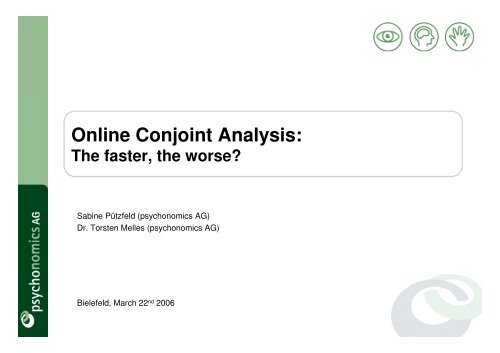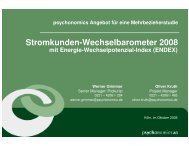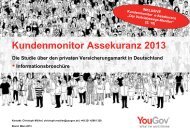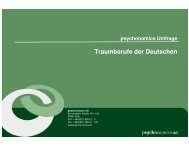Online Conjoint Analysis: - YouGov
Online Conjoint Analysis: - YouGov
Online Conjoint Analysis: - YouGov
Create successful ePaper yourself
Turn your PDF publications into a flip-book with our unique Google optimized e-Paper software.
<strong>Online</strong> <strong>Conjoint</strong> <strong>Analysis</strong>:<br />
The faster, the worse?<br />
Sabine Pützfeld (psychonomics AG)<br />
Dr. Torsten Melles (psychonomics AG)<br />
Bielefeld, March 22 nd 2006
Agenda<br />
I. Introduction: Characteristics of <strong>Conjoint</strong><br />
<strong>Analysis</strong><br />
II.<br />
Research objectives<br />
III. Methodology<br />
IV. Reliability during survey progress<br />
V. Effects of age and product category<br />
VI. Conclusions and directions for future research<br />
2
4 basic characteristics of <strong>Conjoint</strong> <strong>Analysis</strong> (I)<br />
1. Respondents evaluate multiattributive product<br />
stimuli.<br />
paired comparison of car 1 and car 2<br />
3
4 basic characteristics of <strong>Conjoint</strong> <strong>Analysis</strong> (II)<br />
2. Multiple decisions are<br />
made.<br />
4
4 basic characteristics of <strong>Conjoint</strong> <strong>Analysis</strong> (III)<br />
3. Product attributes are<br />
combined systematically.<br />
5
4 basic characteristics of <strong>Conjoint</strong> <strong>Analysis</strong> (IV)<br />
4. The utility of each attribute level („partworth“) is statistically<br />
derived from all judgments.<br />
Partworth 1<br />
+<br />
+<br />
Partworth 2<br />
Partworth 3<br />
<br />
Overall decision<br />
6
Agenda<br />
I. Introduction: Characteristics of <strong>Conjoint</strong><br />
<strong>Analysis</strong><br />
II.<br />
Research objectives<br />
III. Methodology<br />
IV. Reliability during survey progress<br />
V. Effects of age and product category<br />
VI. Conclusions and directions for future research<br />
7
Background: duration per paired comparison in seconds<br />
duration per paired<br />
comparison in seconds<br />
45<br />
40<br />
35<br />
30<br />
25<br />
20<br />
15<br />
10<br />
5<br />
0<br />
warm-up<br />
1 5 10 15 20 25<br />
survey progress (paired comparisons)<br />
On average, the first 5 to 6<br />
paired comparisons of a<br />
conjoint analysis take more<br />
time.<br />
<br />
Independent of the total<br />
number of paired<br />
comparisons, the duration<br />
of the following paired<br />
comparisons is nearly at the<br />
same constant level.<br />
study 1 (n=528)<br />
study 2 (n=163)<br />
study 3 (n=303)<br />
study 4 (n=306)<br />
study 5 (n=262)<br />
8
Problem Formulation<br />
Effect of exhaustion? – Reliability<br />
of the answers declines<br />
or<br />
Effect of routine? – Reliability of<br />
the answers does not decline<br />
9
Agenda<br />
I. Introduction: Characteristics of <strong>Conjoint</strong><br />
<strong>Analysis</strong><br />
II.<br />
Research objectives<br />
III. Methodology<br />
IV. Reliability during survey progress<br />
V. Effects of age and product category<br />
VI. Conclusions and directions for future research<br />
10
Methodology: Database<br />
Peer analysis of 5 <strong>Online</strong> <strong>Conjoint</strong> Analyses:<br />
(1) „checking account“ – November 2004 – 528 respondents from<br />
online panel – 27 paired comparisons (2 versions)<br />
(2) „wall paints“ – January 2005 – 163 respondents from online panel<br />
and recruitment by telephone – 18 paired comparisons<br />
(3) „mobile phone price plans“ – January 2005 – 303 respondents<br />
from online panel – 16 paired comparisons<br />
(4) „building society savings“ – February 2005 – 306 respondents<br />
from online panel – 20 paired comparisons<br />
(5) „car study“ – March 2005 – 262 respondents from online panel –<br />
27 paired comparisons<br />
Order of the paired comparisons was<br />
randomized in each study<br />
11
Methodology: <strong>Analysis</strong> of reliability<br />
Relying on the partworths (derived from responses to all paired comparisons) for<br />
each respondent, an individual pattern of preference will be generated.<br />
At a second stage, the partworths are used to calculate the theoretically correct<br />
answer of each paired comparison, provided that the statements are totally<br />
consistent.<br />
perfect consistency of answer = response on a paired comparison corresponds<br />
to the one calculated on the basis of the individual pattern of preference<br />
Measure of reliability: consistency of answer I<br />
correlation between response on a paired comparison corresponds to the one<br />
calculated on the basis of the individual pattern of preference<br />
Measure of reliability: consistency of answer II<br />
(squared) deviation of response on a paired comparison corresponds to the one<br />
calculated on the basis of the individual pattern of preference<br />
12
Agenda<br />
I. Introduction: Characteristics of <strong>Conjoint</strong><br />
<strong>Analysis</strong><br />
II.<br />
Research objectives<br />
III. Methodology<br />
IV. Reliability during survey progress<br />
V. Effects of age and product category<br />
VI. Conclusions and directions for future research<br />
13
Consistency of answer during survey progress I<br />
(correlation)<br />
consistency of answer<br />
(correlation between actual given answer and<br />
calculated answer)<br />
1<br />
0,9<br />
0,8<br />
0,7<br />
0,6<br />
warm-up effect<br />
<br />
<br />
<br />
Except for the first paired<br />
comparison the correlations<br />
of the considered studies<br />
are on a constantly high<br />
(0.84 – 0.92) level of<br />
consistency.<br />
No decline of consistency<br />
during survey progress<br />
Effect of exhaustion cannot<br />
be confirmed<br />
0,5<br />
1 5 10 15 20 25<br />
survey progress (paired comparisons)<br />
study 1 (n=528)<br />
study 2 (n=163)<br />
study 3 (n=303)<br />
study 4 (n=306)<br />
study 5 (n=262)<br />
14
<strong>Analysis</strong> of consistency of answers<br />
Relying on the partworths (derived from responses to all paired comparisons) for<br />
each respondent an individual pattern of preference will be generated.<br />
On a second step the partworths are used to calculate the theoretically correct<br />
answer of each paired comparison, provided that the statements are totally<br />
consistent.<br />
perfect consistency of answer = response on a paired comparison corresponds<br />
to the one calculated on the basis of the individual pattern of preference<br />
Measure of reliability: consistency of answer I<br />
correlation between response on a paired comparison corresponds to the one<br />
calculated on the basis of the individual pattern of preference<br />
Measure of reliability: consistency of answer II<br />
shows, how far the<br />
answer differs from<br />
predicted value<br />
(squared) deviation of response on a paired comparison corresponds to the one<br />
calculated on the basis of the individual pattern of preference<br />
15
Consistency of answer during survey progress II<br />
(deviation)<br />
first 6 paired comparisons of all considered studies<br />
6%<br />
5%<br />
rel. frequencies<br />
4%<br />
3%<br />
2%<br />
1%<br />
0%<br />
-3 0 3<br />
deviation of actual given answer and<br />
calculated answer<br />
16
Consistency of answer during survey progress II<br />
(deviation)<br />
last 6 paired comparisons of all considered studies<br />
6%<br />
5%<br />
rel. frequencies<br />
4%<br />
3%<br />
2%<br />
1%<br />
0%<br />
-3 0 3<br />
deviation of actual given answer and<br />
calculated answer<br />
17
Consistency of answer during survey progress II<br />
(deviation)<br />
first and last 6 paired comparisons of all<br />
considered studies<br />
6%<br />
<br />
No significant differences<br />
while comparing the<br />
distributions of the<br />
deviations regarding the<br />
first and the last 6 paired<br />
comparisons<br />
rel. frequencies<br />
5%<br />
4%<br />
3%<br />
2%<br />
<br />
<br />
Answers of both survey<br />
parts represent the same<br />
deviation from predicted<br />
value<br />
Effect of exhaustion cannot<br />
be confirmed<br />
1%<br />
0%<br />
-3 0 3<br />
deviation of actual given answer and<br />
calculated answer<br />
18
Agenda<br />
I. Introduction: Characteristics of <strong>Conjoint</strong><br />
<strong>Analysis</strong><br />
II.<br />
Research objectives<br />
III. Methodology<br />
IV. Reliability during survey progress<br />
V. Effects of age and product category<br />
VI. Conclusions and directions for future research<br />
19
Further questions<br />
Based on all respondents, no effects of the consistency<br />
of answer could be determined, which indicate a kind of<br />
exhaustion during progress of paired comparisons.<br />
Does the consistency of answer depend on the age of<br />
the respondent resp. do older people become<br />
exhausted earlier than younger people?<br />
Does the progress of consistency of answer depend on<br />
the product that is tested during the conjoint analysis?<br />
20
Age effects within consistency of answer<br />
1,6<br />
1,4<br />
older respondents<br />
answer less consistently<br />
on principle<br />
Averaged squared deviations of<br />
all paired comparisons<br />
older than 45 years<br />
1,17<br />
squared deviations<br />
1,2<br />
1<br />
0,8<br />
0,6<br />
0,4<br />
0,2<br />
0<br />
1 5 10 15 20 25<br />
survey progress (paired comparisons)<br />
up to 25 years (n=427)<br />
26 to 35 years (n=535)<br />
younger respondents<br />
answer more consistently<br />
on principle<br />
36 to 45 years (n=351)<br />
older than 45 years (n=244)<br />
36 to 45 years<br />
26 to 35 years<br />
up to 25 years<br />
<br />
21<br />
0,77<br />
1,05<br />
0,99<br />
An effect of exhaustion<br />
cannot be confirmed in any<br />
age group
Further questions<br />
Based on all respondents no effects of the consistency<br />
of answer could be determined, which indicate a kind of<br />
exhaustion during progress of paired comparisons.<br />
Does the consistency of answer depend on the age of<br />
the respondent resp. do older people become<br />
exhausted earlier than younger people?<br />
Does the progress of consistency of answer depend on<br />
the product that is tested during the conjoint analysis?<br />
22
Differentiation according to the tested product<br />
squared deviations<br />
2,5<br />
2<br />
1,5<br />
1<br />
0,5<br />
car study<br />
<br />
<br />
checking account<br />
Consistency of answer<br />
depends on the tested<br />
product (resp. on complexity).<br />
However no differences<br />
during the survey progress<br />
can be determined. That<br />
means no effects of<br />
exhaustion could be found in<br />
any of the researched<br />
studies.<br />
0<br />
1 5 10 15 20 25<br />
survey progress (paired comparisons)<br />
study 1 (n=528)<br />
study 2 (n=163)<br />
study 3 (n=303)<br />
study 4 (n=306)<br />
study 5 (n=262)<br />
23
Agenda<br />
I. Introduction: Characteristics of <strong>Conjoint</strong><br />
<strong>Analysis</strong><br />
II.<br />
Research objectives<br />
III. Methodology<br />
IV. Reliability during survey progress<br />
V. Effects of age and product category<br />
VI. Conclusions and directions for future research<br />
24
Conclusion<br />
The analyses indicate, that a decline in reliability during survey progress<br />
of an online conjoint analysis does not appear at all.<br />
Even after 27 paired comparisons, the answers of the respondents are<br />
as consistent as at the beginning of the survey. That applies to<br />
different age groups<br />
different tested products<br />
On the other hand a clear warm-up effect occurs, which confirms the<br />
results of former studies. The respondents require 2 to 3 tasks to reach<br />
the maximum of reliability within theirs statements.<br />
As long as no systematic deviation of the preference statement exists in<br />
this context (but merely a lower reliability), it is not necessary to exclude<br />
the first paired comparisons from the utility estimation. Consequently, it<br />
is not necessary to include special warm-up tasks.<br />
25
Directions for future research<br />
The reliability of the conjoint analysis results has been found to depend<br />
on the age of the respondents and on the tested product. That means:<br />
In order to draw conclusions with the same reliability, different amounts of<br />
data (case number, number of statements per respondent) according to the<br />
age group and to the product to be tested will be necessary. Therefore a<br />
further quantification would be reasonable.<br />
Considering age, one should investigate whether there is a possibility of<br />
creating the tasks for the older people in a different way, so that the answers<br />
will be more reliable.<br />
Considering product category, reasons for differences in reliability should be<br />
explored. Reasons may be e.g. the familiarity with the product or the<br />
involvement or the motivation to participate in the survey.<br />
26
Thank you for your attention!
















